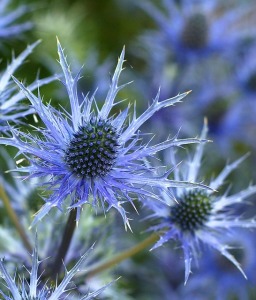
Family: Apiaceae
Genus: Eryngium
Species: Eryngium planum
Common names: sea holly Swedish name: rysk martorn
Eryngium is a genus of flowering plants including about 250 species. The different spieces are distributed almost worldwide wherever their growing conditions are met. The majority are grassland plants but some belongs in rocky or coastal areas. The Eryngium genus contains both annuals and perennials. Several species of Eryngium have been used as food and medicine. The Native American people used many of them for varied purposes. Eryngium yields an essential oil and extracts have anti-inflammatory properties. The roots have been used as vegetables or sweetmeats. Young shoots and leaves are sometimes used like asparagus.
Eryngium planum is native in central and southeastern Europe as well as central Asia. The essential oils and bioactive compounds of it are used in European folk medicine as diuretic, stimulant, and appetizer. Ethanolic extracts of shoots and roots show a significant antifungal and moderate antibacterial activity.
Description: Eryngium planum is a herbaceous perennial thistle with branched silvery-blue stems, and numerous small blue conical flower heads surrounded by spiky bracts in summer. It is very beautiful to use in flower arrangements, fresh or dried (eternal). It is also attractive to use in garden beds, since it is a very hardy species adding superb color. The shimmering blue being a nice contrast to yellow or gold neighbours. Attracts butterflies.
How to grow: Eryngium planum is easy to divide in early spring. It requires low maintenance and is easy to take care of. Tolerant of hot, dry sites, and soils high in salts which makes it suitable in coastal gardens and along roads which may be salted during winter time.
Herbal and medicinal plants: traditional and folk medicine has laid the ground for many modern medicines produced today. Without the research and knowledge gained in history modern medicine would have looked very different. If it even had existed. Nature is still a source of new remedies and studies are done on newly discovered plants. To be able to make new medicines for modern diseases. I think it is a very interesting history to take part of so I thought I would share this link with you:
Sadly the use of traditional medicine has led to extinction or alarming threats of several spieces. Since harvesting and collecting have been to intensive. Meanwhile modern medicine have leaked out in our water systems via the sewers causing disturbances in the reproduction of aquatic species among other things. Yet again we have sustainability issues to tackle to ensure a healthy planet.



That was really interesting! I learned a little something today. Happy A-Zing!
LikeLike
Thank you!
LikeLike
An interesting looking plant!
LikeLiked by 1 person
What a gorgeous and unique flower!
Good luck with the 2015 A to Z Challenge!
A to Z Co-Host S. L. Hennessy
http://pensuasion.blogspot.com
LikeLiked by 1 person
Thank you for stopping by. I enjoy the A to Z Challenge. I have found many nice bloggers and interesting blogs. I hope I will make it through. Have a great week!
LikeLike
I would love to have this in my garden, especially if it attracts butterflies. I’ll have to look up and see if it grows easily in my area. I am really enjoying your blog this April, Lisa, co-host AtoZ 2015, @ http://www.lisabuiecollard.com I’m glad you dropped by mine!
LikeLike
Thank you Lisa! I am happy you found my blog and enjoy it. I hope the sea holly will grow in your area. Otherwise there are several Eryngium species – some will surely be suitable.
LikeLike
Wow.. i have not seen this flower. Looks beautiful.
LikeLiked by 1 person
Oh, it is – especially when the butterflies swirl around it.
LikeLike
I don’t think I have ever seen this plant before. I agree with you on the prescription drugs that are ending up in our water and doing a lot of damage both to aquatic life and our own health.
LikeLike
It is sad. I hope it will be solved soon…
LikeLike